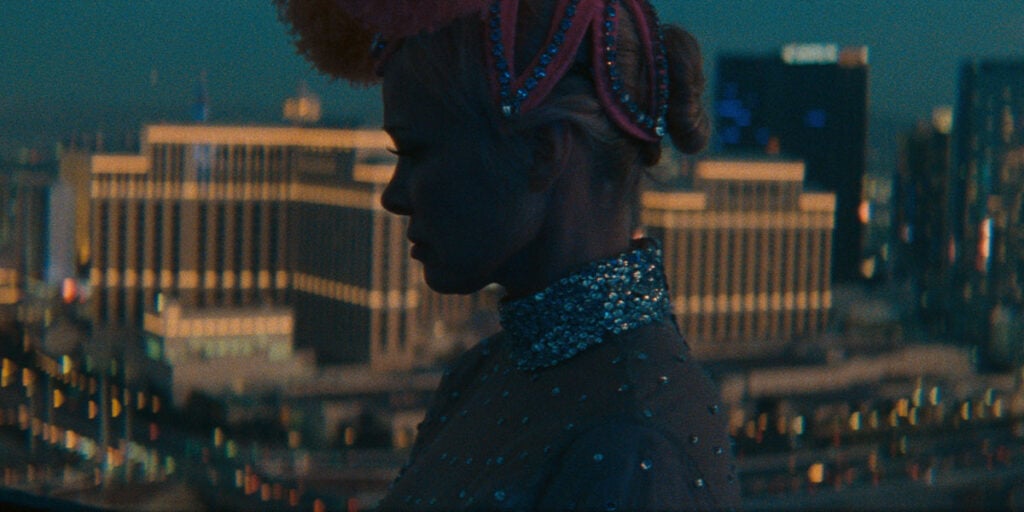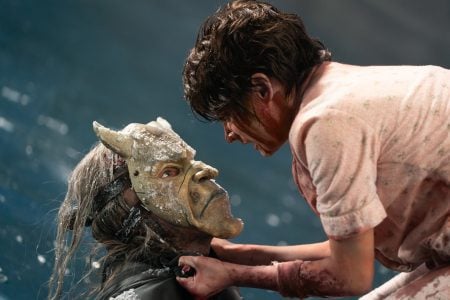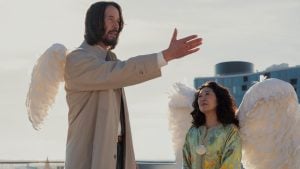It’s hard to think of a better pairing of role and actor than The Last Showgirl’s Shelley and Pamela Anderson.
The parallels are unmistakable on paper. Both Shelley and Anderson are key sex symbols of their respective worlds: Las Vegas and Hollywood. After years of cultural ubiquity and fervent adoration, they are faced with shifting cultural priorities and advancing age, neither of which are particularly kind to people like them. It’s a brilliant bit of meta-casting, especially in the wake of an overdue reappraisal of the zeitgeist’s treatment of Anderson at the height of her powers, sparked by the Emmy-nominated limited series Pam & Tommy and the Netflix documentary film Pamela, a Love Story. The inevitable question is, how far does such a reappraisal go? Can Anderson capitalize on this renewed cultural relevance to deliver a performance that redefines what everyone thought she could do?
Yes, so much so that it stands to reason that The Last Showgirl might be a step below her true capabilities.
In The Last Showgirl, Anderson plays Shelley, the lead performer in Le Razzle Dazzle, a long-running semi-nude musical revue on the Las Vegas strip. The show is central to Shelly’s life, and she’s built a semi-close-knit community of show staff, including cocktail waitress Annette (Jamie Lee Curtis), stage manager and one-time love interest Eddie (Dave Bautista), and fellow showgirls Marianne (Brenda Song) and Jodie (Kiernan Shipka). That community is upended when Eddie announces that the show is shutting down in two weeks in favor of a family-friendly circus act. Shelley reels from the news, having staked her life on the show, and fears she has little to show for it after 30 years. She uses her time in the lead-up to Le Razzle Dazzle’s end to take stock of her life, starting with an attempt to reconnect with her adult daughter Hannah (Billie Lourd).
Given the similarities, one might assume that Anderson isn’t acting much in The Last Showgirl. That would be a mistake. Anderson easily delivers her best-ever performance, leveraging her natural charisma and command of the camera to appeal Shelley to the audience. Cliched as it is, she does indeed dazzle on screen. Beyond that, Anderson plays Shelley with a weathered innocence. She hints that Shelley is fully aware of her circumstances and is far more astute than anyone gives her credit for being. The girlish affectations are a tool that Shelley uses to bolster and use people’s expectations for her benefit while protecting herself from the sobering reality that her emotional and financial security is conditional, with an expiration date. It’s very compelling to watch throughout the film, especially when Anderson has the opportunity to take the industries that have felled Shelley (and, by extension, herself) to task for their callous treatment.
Sadly, those opportunities aren’t quite as plentiful as they should be. The Last Showgirl splits its attention between the sociopolitical dynamics that have gutted Le Razzle Dazzle and the interpersonal relationships that have formed alongside the revue. Director Gia Coppola’s strongest work comes from exploring the former. She conceives the Vegas Strip through a gritty, gauzy lens, giving it a dreamlike atmosphere that reflects how Shelley sees the world while acknowledging its inherent artifice. One of the film’s best scenes has Annette shamelessly dancing on the casino floor to Bonnie Tyler’s “Total Eclipse of the Heart,” intercut with Shelley’s breakdown on the roof, overlooking the Strip she’s called home for three decades. It’s a startlingly honest sequence that encapsulates how older women are seen and ignored by an industry sustained by the beauty of their younger selves.
Coppola takes a more pointed stance with Shelley’s audition for a new Vegas act, which opens and helps close the film. Shelley is humiliated by the director, who tells her point-blank that she lacks talent and was likely only hired at Le Razzle Dazzle because she was young and beautiful. What goes unsaid but is glaringly obvious is how men aren’t judged by the same punitive standards. (Eddie can comfortably stay on as stage manager.) Coppola extracts real impact by showing how Le Razzle Dazzle’s women struggle to reconcile the show’s closing with their shaky place in the Vegas pecking order. That impact is dampened by her approach to the troupe’s interpersonal dynamics. Shelley’s relationships with Hannah and Eddie feel underdeveloped and reliant on archetypal conventions. It ultimately leaves the film more emotionally distant than it likely means to be.
The Last Showgirl does have a strong supporting cast working to balance out the film. Jamie Lee Curtis turns in another strong late-career performance as Annette, clearly relishing in the waitress’s bawdy, tawdry sensibilities but still finding grace notes to keep her from devolving into caricature. Kiernan Shipka and Brenda Song each have great moments as their characters grapple with their financial and career needs in the wake of Le Razzle Dazzle’s close. The film’s greatest surprise, apart from Anderson, is Dave Bautista. He makes an undeniable impact with a relatively minor role, radiating grace and sensitivity as the imposing-looking but tender-hearted Eddie. The tentative but palpable ache he communicates through his eyes, particularly when focused on Anderson, is very moving and makes the yearning for a more fleshed-out narrative for Eddie and Shelley even stronger.
On paper, The Last Showgirl solely exists to prove that Hollywood failed Pamela Anderson even more than previously thought, that she could be a compelling actress. In practice, Gia Coppola’s film achieves something far more interesting. The script and direction’s unevenness hold Anderson back, relegating her to merely fleeting moments of excellence. Tempting as it is to label it as the arrival of a renaissance for the cultural icon, the film doesn’t quite earn that distinction. What may be more valuable is how it sets Anderson up for the future, offering her opportunities beyond her public persona. Given what she’s accomplished and endured, she deserves the chance.
The Last Showgirl held its World Premiere as part of the Special Presentations section at the 2024 Toronto International Film Festival.
Director: Gia Coppola
Writer: Kate Gersten
Rated: NR
Runtime: 85m
On paper, The Last Showgirl solely exists to prove that Hollywood failed Pamela Anderson even more than previously thought, that she could be a compelling actress. In practice, Gia Coppola’s film achieves something far more interesting.
-
GVN Rating 7
-
User Ratings (0 Votes)
0
A late-stage millennial lover of most things related to pop culture. Becomes irrationally irritated by Oscar predictions that don’t come true.






![‘Frankenstein’ Review – Guillermo del Toro’s Definitive Look At The Nature And Nurture Of Monstrosity [TIFF 2025] ‘Frankenstein’ Review – Guillermo del Toro’s Definitive Look At The Nature And Nurture Of Monstrosity [TIFF 2025]](https://cdn.geekvibesnation.com/wp-media-folder-geek-vibes-nation/wp-content/uploads/2025/10/Frankenstein-175_PF_20240430_20377_R-300x200.jpg)